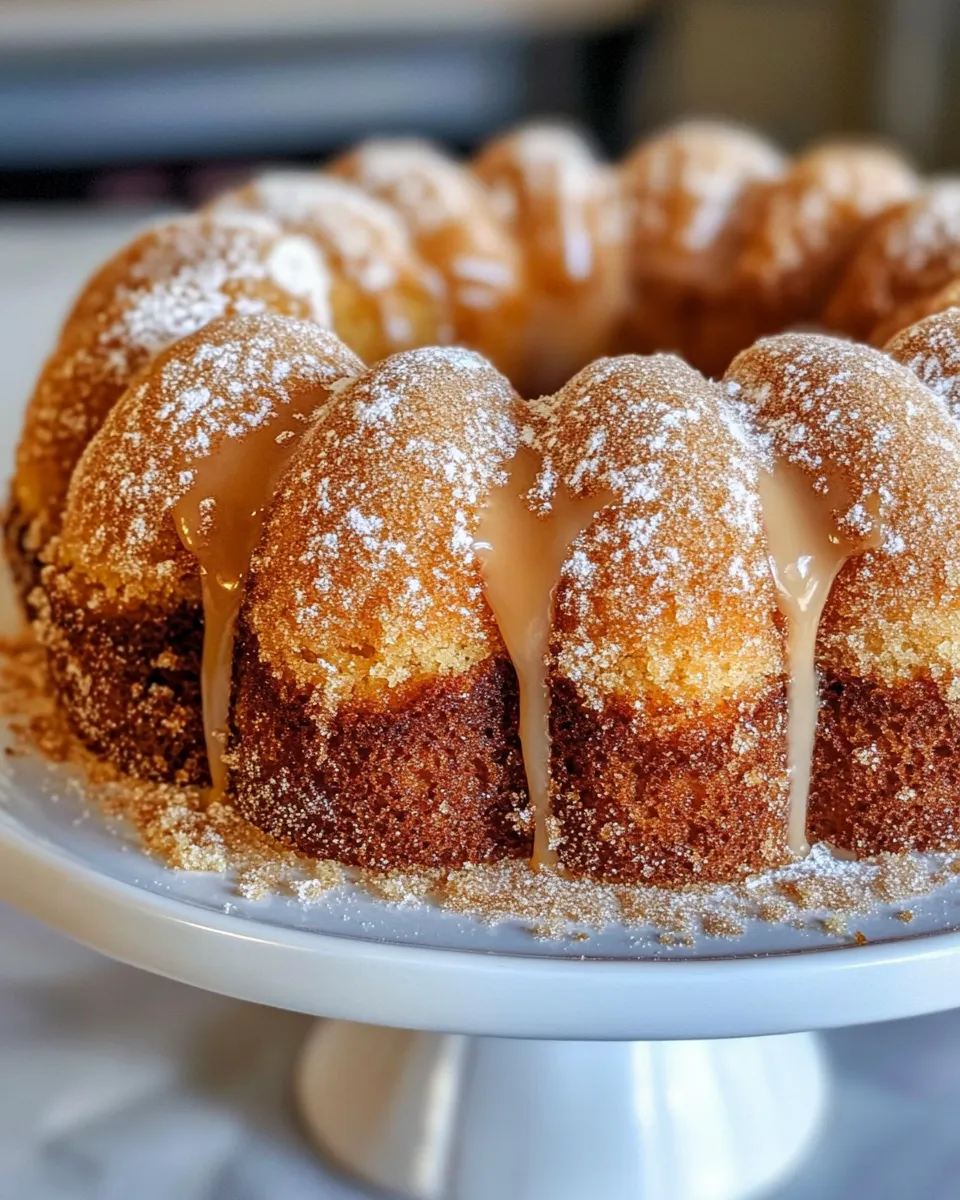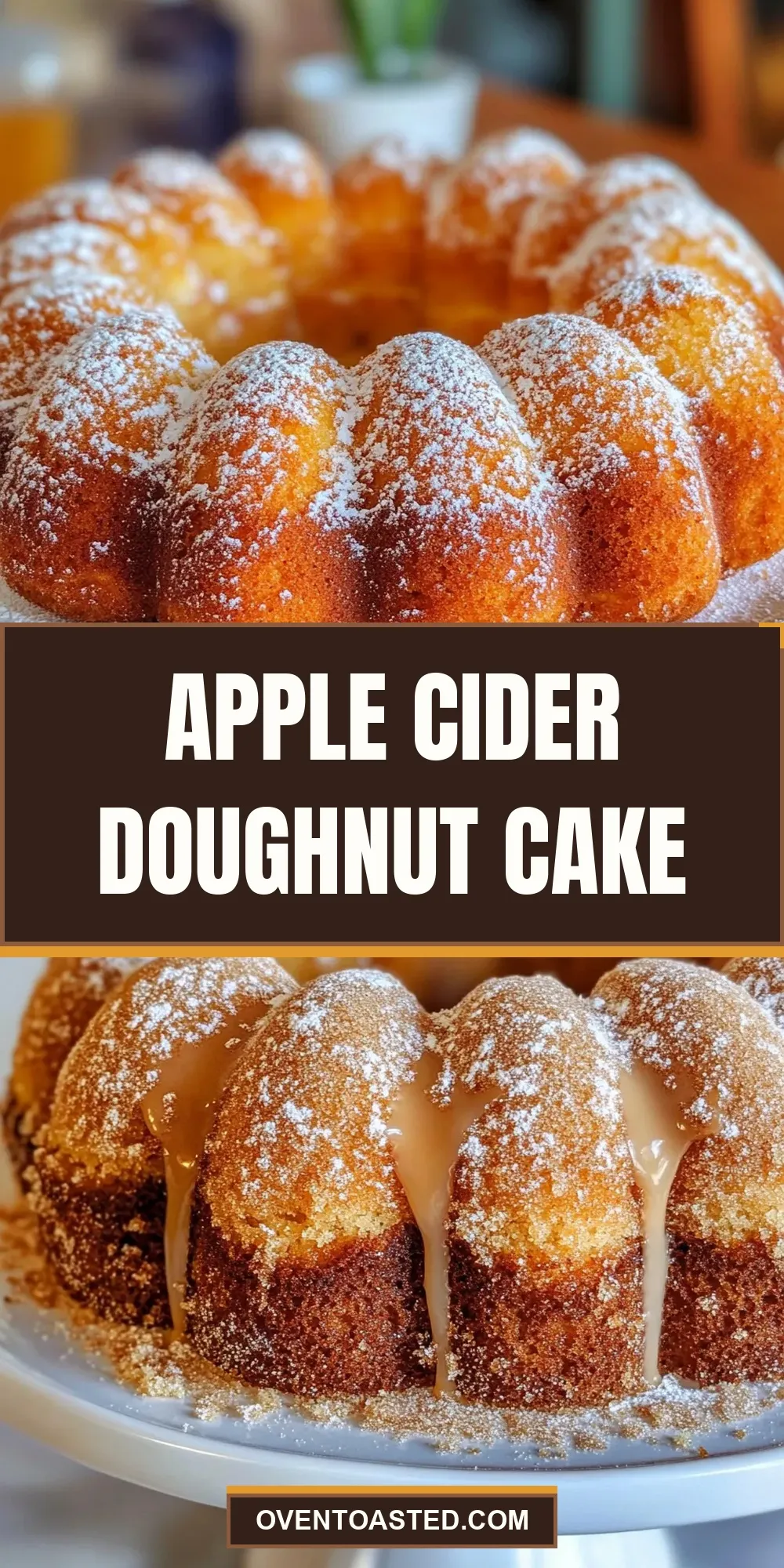Apple Cider Doughnut Cake
There’s something irresistibly cozy and nostalgic about the taste of apple cider doughnuts, and what if you could enjoy that flavor in a delightful cake form? Enter the Apple Cider Doughnut Cake—a moist, spiced cake bursting with the warm notes of cinnamon and nutmeg, perfectly capturing the essence of fall in every bite. This cake offers the comforting flavors of classic Apple Cider Donuts but in a simple, sliceable form that’s perfect for sharing with family and friends. Whether you’re hosting a brunch, looking for a sweet treat after dinner, or just craving something special, this cake hits the spot effortlessly.
The Upside of Apple Cider Doughnut Cake
One of the greatest joys of the Apple Cider Doughnut Cake is its unique blend of autumnal spices combined with the natural sweetness and tang of apple cider. Unlike traditional doughnuts, this cake is incredibly easy to make and requires no frying, making it a less messy but equally indulgent option. The texture is tender and slightly crumbly, reminiscent of a doughnut, but with the satisfying heft of cake. Plus, the cinnamon-sugar topping adds a delightful crunch that mimics the classic doughnut coating, giving each slice an extra layer of flavor and texture.
This cake also serves as a fantastic way to use up leftover apple cider, especially during the cooler months when apple orchards are abundant and fresh cider is flowing. It’s a crowd-pleaser that pairs beautifully with a cup of coffee or tea, inviting you to slow down and savor the season.
Ingredient Notes
- All-purpose flour: The base of the cake providing structure and a tender crumb.
- Granulated sugar: Sweetens the cake while helping with moisture retention.
- Baking powder and baking soda: Leavening agents that ensure the cake rises perfectly and stays light.
- Ground cinnamon and nutmeg: Classic fall spices that infuse the cake with warmth and depth.
- Salt: Enhances all the flavors, balancing sweetness and spices.
- Unsalted butter: Adds richness and moisture; make sure it’s softened for easy mixing.
- Apple cider: The star ingredient, lending natural sweetness and tang with a hint of fruitiness.
- Large eggs: Provide structure and richness; room temperature eggs mix better.
- Vanilla extract: Enhances the overall flavor and complements the spices.
- Brown sugar: Adds moisture and a slight caramel note to the cake.
- Granulated sugar and ground cinnamon (for topping): Create the signature doughnut-like cinnamon sugar crust on top of the cake.
Cook’s Kit
- 9-inch round cake pan: Ideal for baking the Apple Cider Doughnut Cake evenly.
- Mixing bowls: For combining dry and wet ingredients separately.
- Electric mixer or whisk: To cream butter and sugar until fluffy.
- Measuring cups and spoons: For accuracy in ingredient amounts.
- Spatula: Helpful for folding ingredients gently and scraping the bowl.
- Cooling rack: To cool the cake completely before adding the cinnamon sugar topping.
Method: Apple Cider Doughnut Cake
Step 1: Preheat and Prepare
Preheat your oven to 350°F (175°C). Grease a 9-inch round cake pan with butter or non-stick spray and lightly dust it with flour, or line it with parchment paper for easy removal.
Step 2: Mix Dry Ingredients
In a large bowl, sift together 2 cups of all-purpose flour, 1 teaspoon baking powder, 1 teaspoon baking soda, 1 teaspoon ground cinnamon, 1/2 teaspoon ground nutmeg, and 1/2 teaspoon salt. Set aside.
Step 3: Cream Butter and Sugars
In a separate bowl, beat 1/2 cup softened unsalted butter, 1 cup granulated sugar, and 1/2 cup brown sugar until the mixture is light and fluffy—this usually takes about 3 to 4 minutes with an electric mixer.
Step 4: Add Eggs and Vanilla
Beat in 2 large eggs one at a time, ensuring each is fully incorporated before adding the next. Then mix in 1 teaspoon vanilla extract for that subtle, aromatic sweetness.
Step 5: Combine Wet and Dry Ingredients
Gradually add the dry ingredient mixture to the wet ingredients, alternating with 1 cup of apple cider. Begin and end with the dry ingredients, mixing gently to combine but being careful not to overmix, which can toughen the cake.
Step 6: Bake
Pour the batter into your prepared cake pan and smooth the top with a spatula. Bake for about 35-40 minutes, or until a toothpick inserted into the center comes out clean.
Step 7: Cinnamon Sugar Topping
While the cake bakes, mix together 1/4 cup granulated sugar and 1 teaspoon ground cinnamon in a small bowl. Once the cake is out of the oven and still warm, brush the top lightly with melted butter (optional for extra richness), then sprinkle the cinnamon sugar mixture generously over the surface to create a crisp, sweet crust reminiscent of classic doughnut toppings.
Step 8: Cool and Serve
Allow the cake to cool in the pan for 15 minutes before transferring it to a wire rack to cool completely. Slice, serve, and enjoy the cozy flavors inspired by Caramel Apple Stuffed Cupcakes and other autumn delights.
Make It Diet-Friendly
- Substitute unsweetened applesauce for half the butter to reduce fat content while keeping the cake moist.
- Use coconut sugar or a natural sweetener like maple syrup instead of granulated and brown sugar for a more natural sweetness.
- Try whole wheat pastry flour in place of all-purpose flour to add fiber and nutrients.
- Reduce sugar topping or use a cinnamon dusting without sugar for fewer calories on top.
Testing Timeline
After several rounds of testing, here’s when you can expect your Apple Cider Doughnut Cake to be at its best:
- Right out of the oven: The cake is warm and soft, ideal for immediate indulgence.
- After cooling for 1 hour: Flavors meld beautifully, and the cinnamon sugar topping crisps perfectly.
- Day 2: Store wrapped at room temperature; the cake remains moist but the topping softens slightly.
- Day 3-4: Best enjoyed warmed up in the microwave or oven to revive texture and flavor.
Save It for Later
To store your Apple Cider Doughnut Cake, wrap it tightly in plastic wrap or place it in an airtight container at room temperature for up to 3 days. For longer storage, slice and freeze pieces individually in freezer-safe bags for up to 2 months. When ready to enjoy, thaw at room temperature and warm slightly for that fresh-baked feel.
Common Qs About Apple Cider Doughnut Cake
Can I use fresh apple cider or does it need to be store-bought?
Both fresh and store-bought apple cider work wonderfully in this recipe. Fresh cider will give a more vibrant apple flavor, while store-bought cider is perfectly fine and often more convenient.
Is it possible to make this cake gluten-free?
Yes! Substitute the all-purpose flour with a gluten-free blend that includes xanthan gum for structure. Be sure to check the blend’s ratio for a 1:1 substitution to maintain the cake’s texture.
Can I turn this cake into cupcakes?
Absolutely. Divide the batter evenly among cupcake liners and reduce bake time to about 18-22 minutes. Keep an eye on them and test doneness with a toothpick.
How do I get the perfect cinnamon sugar topping without it melting into the cake?
The key is to sprinkle the cinnamon sugar topping while the cake is still warm and optionally brush the top with melted butter first. This helps the topping stick and form a slightly crisp crust instead of soaking in.
More from the Kitchen
- Apple Cider Donuts – If you love the flavors of this cake, try your hand at these classic fried treats.
- Caramel Apple Stuffed Cupcakes – Another delicious apple-inspired dessert with a surprise caramel center.
Hungry for More?
If the cozy spices and apple cider flavors of this cake have piqued your interest, be sure to explore other autumn-inspired recipes that bring warmth and sweetness to your kitchen. From spiced muffins to caramel-drizzled treats, there’s no shortage of ways to celebrate the season’s bounty.
The Apple Cider Doughnut Cake is a fantastic way to capture the essence of fall in one simple, satisfying dessert. With its tender crumb, spicy warmth, and sweet cinnamon sugar crunch, it’s a recipe that invites you to slow down and savor every bite. Whether you’re baking for a special occasion or just because, this cake is sure to become a favorite in your recipe collection. Happy baking!
Share on Pinterest

Apple Cider Doughnut Cake
Ingredients
Equipment
Method
- Preheat your oven to 350°F (175°C). Grease a 9-inch round cake pan with butter or non-stick spray and lightly dust it with flour, or line it with parchment paper for easy removal.
- In a large bowl, sift together 2 cups of all-purpose flour, 1 teaspoon baking powder, 1 teaspoon baking soda, 1 teaspoon ground cinnamon, ½ teaspoon ground nutmeg, and ½ teaspoon salt. Set aside.
- In a separate bowl, beat ½ cup softened unsalted butter, 1 cup granulated sugar, and ½ cup brown sugar until the mixture is light and fluffy—about 3 to 4 minutes with an electric mixer.
- Beat in 2 large eggs one at a time, ensuring each is fully incorporated before adding the next. Then mix in 1 teaspoon vanilla extract.
- Gradually add the dry ingredient mixture to the wet ingredients, alternating with 1 cup of apple cider. Begin and end with the dry ingredients, mixing gently to combine but being careful not to overmix.
- Pour the batter into your prepared cake pan and smooth the top with a spatula. Bake for about 35-40 minutes, or until a toothpick inserted into the center comes out clean.
- While the cake bakes, mix together ¼ cup granulated sugar and 1 teaspoon ground cinnamon in a small bowl. Once the cake is out of the oven and still warm, brush the top lightly with melted butter (optional), then sprinkle the cinnamon sugar mixture generously over the surface.
- Allow the cake to cool in the pan for 15 minutes before transferring it to a wire rack to cool completely. Slice, serve, and enjoy.
Notes
- Substitute unsweetened applesauce for half the butter to reduce fat while keeping the cake moist.
- Use coconut sugar or maple syrup instead of granulated and brown sugar for a natural sweetness.
- Try whole wheat pastry flour for added fiber and nutrients.
- Reduce or omit sugar in the topping for fewer calories.
- Store cake wrapped at room temperature for up to 3 days or freeze slices for up to 2 months.








